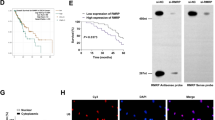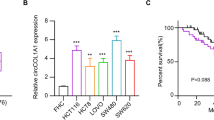Abstract
Increasing studies indicate that circular RNAs (circRNAs) play critical roles in tumor metabolism of multiple cancers. However, the contribution of circRNAs in glutamine metabolism of esophageal squamous cell carcinoma (ESCC) remains elusive. The objective of this research was to investigate the role and mechanism of circRNA hsa_circ_0001093 (circ_0001093) in the glutamine metabolism and tumorigenesis of ESCC. Circ_0001093, microRNA-579-3p (miR-579-3p) and glutaminase (GLS) expressions in ESCC tissues and cell lines were measured by qRT-PCR, tissue array or Western blot. Cell proliferation, invasion and migration were assessed by CCK-8 or transwell assays. Glutamine consumption, glutamate and ATP production were detected by indicated assay kits. The relationships between circ_0001093 and miR-579-3p or GLS mRNA were investigated by bioinformatics analysis, RNA pull-down, luciferase reporter and RNA immunoprecipitation (RIP) assays. Here, we found that circ_0001093 expression was up-regulated in ESCC tissues and cell lines. Increased circ_0001093 expression predicted an unfavourable prognosis, and was associated with the lymph node metastasis, TNM staging and tumor size in ESCC tissues. Circ_0001093 knockdown suppressed cell proliferation, invasion, migration and glutamine metabolism of ESCC cells, while circ_0001093 over-expression showed the opposite effects. Mechanistically, circ_0001093 acted as a competing endogenous RNA (ceRNA) by sponging miR-579-3p, thereby increasing GLS expression. Furthermore, the inhibitory effects of circ_0001093 knockdown on the invasion, migration and glutamine metabolism were partly rescued by miR-579-3p inhibition or GLS over-expression in ESCC cells. Additionally, miR-579-3p expression was down-regulated in ESCC tissues, while GLS expression was up-regulated. In conclusion, this study first provides evidence that the circ_0001093/miR-579-3p/GLS regulatory network can affect glutamine metabolism and malignant phenotype of ESCC, which can further impact ESCC progression.






Similar content being viewed by others
Data availability
Please contact the correspondence author for the data request.
References
Abnet CC, Arnold M, Wei WQ (2018) Epidemiology of esophageal squamous cell carcinoma. Gastroenterology 154(2):360–373. https://doi.org/10.1053/j.gastro.2017.08.023
Bolger JC, Donohoe CL, Lowery M, Reynolds JV (2021) Advances in the curative management of oesophageal cancer. Br J Cancer 1–12. https://doi.org/10.1038/s41416-021-01485-9
Chang Z, Fu Y, Jia Y, Gao M, Song L, Zhang W, Zhao R, Qin Y (2021) Circ-SFMBT2 drives the malignant phenotypes of esophageal cancer by the miR–107-dependent regulation of SLC1A5. Cancer Cell Int 21(1):495. https://doi.org/10.1186/s12935-021-02156-8
Chen J, Gu J, Tang M, Liao Z, Tang R, Zhou L, Su M, Jiang J, Hu Y, Chen Y, Zhou Y, Liao Q, Xiong W, Zhou J, Tang Y, Nie S (2021) Regulation of cancer progression by circRNA and functional proteins. J Cell Physiol [published online ahead of print, 2021 Oct 21.]. https://doi.org/10.1002/jcp.30608
DiSiena M, Perelman A, Birk J, Rezaizadeh H (2021) Esophageal cancer: an updated review. South Med J 114(3):161–168. https://doi.org/10.14423/SMJ.0000000000001226
Fattore L, Mancini R, Acunzo M, Romano G, Laganà A, Pisanu ME, Malpicci D, Madonna G, Mallardo D, Capone M, Fulciniti F, Mazzucchelli L, Botti G, Croce CM, Ascierto PA, Ciliberto G (2016) miR–579–3p controls melanoma progression and resistance to target therapy. Proc Natl Acad Sci U S A 113(34):E5005–E5013. https://doi.org/10.1073/pnas.1607753113
Feng Q, Zhang H, Yao D, Chen WD, Wang YD (2019) Emerging role of non-coding RNAs in esophageal squamous cell carcinoma. Int J Mol Sci 21(1):258. https://doi.org/10.3390/ijms21010258
Guan H, Luo W, Liu Y, Li M (2021) Novel circular RNA circSLIT2 facilitates the aerobic glycolysis of pancreatic ductal adenocarcinoma via miR–510–5p/c-Myc/LDHA axis. Cell Death Dis 12(7):645. https://doi.org/10.1038/s41419-021-03918-y
He AT, Liu J, Li F, Yang BB (2021) Targeting circular RNAs as a therapeutic approach: current strategies and challenges. Signal Transduct Target Ther 6(1):185. https://doi.org/10.1038/s41392-021-00569-5
Huang Y, Zhang C, Xiong J, Ren H (2020) Emerging important roles of circRNAs in human cancer and other diseases. Genes Dis 8(4):412–423. https://doi.org/10.1016/j.gendis.2020.07.012
Jiang L, Wang Y, Tang H, Li X, Huang C, Liu Z, Zhou F, Wang X, Li Y (2021) CircCA12 promotes malignant process via sponging miR–1184 and upregulating RAS family in bladder cancer. Front Genet 12:663982. https://doi.org/10.3389/fgene.2021.663982
Li J, Sun D, Pu W, Wang J, Peng Y (2020) Circular RNAs in cancer: biogenesis, function, and clinical significance. Trends Cancer 6(4):319–336. https://doi.org/10.1016/j.trecan.2020.01.012
Li J, Xu J, Zheng Y, Gao Y, He S, Li H, Zou K, Li N, Tian J, Chen W, He J (2021) Esophageal cancer: Epidemiology, risk factors and screening. Chin J Cancer Res 33(5):535–547. https://doi.org/10.21147/j.issn.1000-9604.2021.05.01
Liang H, Fan JH, Qiao YL (2017) Epidemiology, etiology, and prevention of esophageal squamous cell carcinoma in China. Cancer Biol Med 14(1):33–41. https://doi.org/10.20892/j.issn.2095-3941.2016.0093
Liang Z, Zhao B, Hou J, Zheng J, Xin G (2021) CircRNA circ-OGDH (hsa_circ_0003340) acts as a ceRNA to regulate glutamine metabolism and esophageal squamous cell carcinoma progression by the miR–615–5p/PDX1 Axis. Cancer Manag Re 13:3041–3053. https://doi.org/10.2147/CMAR.S290088
Liu Z, Lu X, Wen L, You C, Jin X, Liu J (2021) Hsa_circ_0014879 regulates the radiosensitivity of esophageal squamous cell carcinoma through miR–519–3p/CDC25A axis. Anticancer Drugs. [published online ahead of print, 2021 Aug 16.]. https://doi.org/10.1097/CAD.0000000000001213
Lu Y, Li Z, Lin C, Zhang J, Shen Z (2021) Translation role of circRNAs in cancers. J Clin Lab Anal 35(7):e23866. https://doi.org/10.1002/jcla.23866
Luan W, Zhou Z, Zhu Y, Xia Y, Wang J, Xu B (2018) miR–137 inhibits glutamine catabolism and growth of malignant melanoma by targeting glutaminase. Biochem Biophys Res Commun 495(1):46–52. https://doi.org/10.1016/j.bbrc.2017.10.152
Masisi BK, El Ansari R, Alfarsi L, Rakha EA, Green AR, Craze ML (2020) The role of glutaminase in cancer. Histopathology 76(4):498–508. https://doi.org/10.1111/his.14014
Mukha A, Kahya U, Dubrovska A (2021) Targeting glutamine metabolism and autophagy: the combination for prostate cancer radiosensitization. Autophagy. 2021:1–3. https://doi.org/10.1080/15548627.2021.1962682
Obara-Michlewska M, Szeliga M (2020) Targeting glutamine addiction in gliomas. Cancers (Basel) 12(2):310. https://doi.org/10.3390/cancers12020310
Pallett LJ, Dimeloe S, Sinclair LV, Byrne AJ, Schurich A (2021) A glutamine ‘tug-of-war’: targets to manipulate glutamine metabolism for cancer immunotherapy. Immunother Adv 1(1):ltab010. https://doi.org/10.1093/immadv/ltab010
Qian C, Chen S, Li S, Wang Y, Yao J (2021) Circ_0000003 regulates glutamine metabolism and tumor progression of tongue squamous cell carcinoma via the miR–330–3p/GLS axis. Oncol Rep 45(4):45. https://doi.org/10.3892/or.2021.7996
Takaki W, Konishi H, Shoda K, Arita T, Kataoka S, Shibamoto J, Furuke H, Takabatake K, Shimizu H, Komatsu S, Shiozaki A, Fujiwara H, Masuda K, Otsuji E (2021) Significance of circular FAT1 as a prognostic factor and tumor suppressor for esophageal squamous cell carcinoma. Ann Surg Oncol 28(13):8508–8518. https://doi.org/10.1245/s10434-021-10089-9
Tao M, Zheng M, Xu Y, Ma S, Zhang W, Ju S (2021) CircRNAs and their regulatory roles in cancers. Mol Med 27(1):94. https://doi.org/10.1186/s10020-021-00359-3
Waters JK, Reznik SI (2022) Update on management of squamous cell esophageal cancer. Curr Oncol Rep. https://doi.org/10.1007/s11912-021-01153-4
Wawrzyniak O, Zarębska Ż, Kuczyński K, Gotz-Więckowska A, Rolle K (2020) Protein-related circular RNAs in human pathologies. Cells 9(8):1841. https://doi.org/10.3390/cells9081841
Weidle UH, Nopora A (2022) MicroRNAs and corresponding targets in esophageal cancer as shown in vitro and in vivo in preclinical models. Cancer Genomics Proteomics 19(2):113–129. https://doi.org/10.21873/cgp.20308
Wicker CA, Hunt BG, Krishnan S, Aziz K, Parajuli S, Palackdharry S, Elaban WR, Wise-Draper TM, Mills GB, Waltz SE, Takiar V (2021) Glutaminase inhibition with telaglenastat (CB-839) improves treatment response in combination with ionizing radiation in head and neck squamous cell carcinoma models. Cancer Lett 502:180–188. https://doi.org/10.1016/j.canlet.2020.12.038
Wu RR, Zhong Q, Liu HF, Liu SB (2019) Role of miR–579–3p in the development of squamous cell lung carcinoma and the regulatory mechanisms. Eur Rev Med Pharmacol Sci 23(21):9464–9470. https://doi.org/10.26355/eurrev_201911_19440
Xi J, Sun Y, Zhang M, Fa Z, Wan Y, Min Z, Xu H, Xu C, Tang J (2019) GLS1 promotes proliferation in hepatocellular carcinoma cells via AKT/GSK3β/CyclinD1 pathway. Exp Cell Res 381(1):1–9. https://doi.org/10.1016/j.yexcr.2019.04.005
Xu J, Xu W, Yang X, Liu Z, Sun Q (2021) LncRNA HCG11/miR–579–3p/MDM2 axis modulates malignant biological properties in pancreatic carcinoma via Notch/Hes1 signaling pathway. Aging 13(12):16471–16484. https://doi.org/10.18632/aging.203167
Yang SJ, Wang DD, Zhong SL, Chen WQ, Wang FL, Zhang J, Xu WX, Xu D, Zhang Q, Li J, Zhang HD, Hou JC, Mao L, Tang JH (2021a) Tumor-derived exosomal circPSMA1 facilitates the tumorigenesis, metastasis, and migration in triple-negative breast cancer (TNBC) through miR–637/Akt1/β-catenin (cyclin D1) axis. Cell Death Dis 12(5):420. https://doi.org/10.1038/s41419-021-03680-1
Yang WH, Qiu Y, Stamatatos O, Janowitz T, Lukey MJ (2021b) Enhancing the efficacy of glutamine metabolism inhibitors in cancer therapy. Trends Cancer 7(8):790–804. https://doi.org/10.1016/j.trecan.2021.04.003
Yu J, Chen X, Li J, Wang F (2021) CircRUNX1 functions as an oncogene in colorectal cancer by regulating circRUNX1/miR–485–5p/SLC38A1 axis. Eur J Clin Invest 51(7):e13540. https://doi.org/10.1111/eci.13540
Zhang H, Ju L, Hu P, Ye J, Yang C, Huang J (2021) Circular RNA 0014715 facilitates cell proliferation and inhibits apoptosis in esophageal squamous cell carcinoma. Cancer Manag Res 13:4735–4749. https://doi.org/10.2147/CMAR.S314882
Zhang X, Lu N, Wang L, Wang Y, Li M, Zhou Y, Yan H, Cui M, Zhang M, Zhang L (2020) Circular RNAs and esophageal cancer. Cancer Cell Int 20:362. https://doi.org/10.1186/s12935-020-01451-0
Zhao JP, Chen LL (2020) Circular RNA MAT2B induces colorectal cancer proliferation via sponging miR–610, resulting in an increased E2F1 expression. Cancer Manag Res 12:7107–7116. https://doi.org/10.2147/CMAR.S251180
Zhou J, Qiu C, Fan Z, Liu T, Liu T (2021a) Circular RNAs in stem cell differentiation: a sponge-like role for miRNAs. Int J Med Sci 18(11):2438–2448. https://doi.org/10.7150/ijms.56457
Zhou PL, Wu Z, Zhang W, Xu M, Ren J, Zhang Q, Sun Z, Han X (2021b) Circular RNA hsa_circ_0000277 sequesters miR–4766–5p to upregulate LAMA1 and promote esophageal carcinoma progression. Cell Death Dis 12(7):676. https://doi.org/10.1038/s41419-021-03911-5
Zhou X, Liu K, Cui J, Xiong J, Wu H, Peng T, Guo Y (2021c) Circ-MBOAT2 knockdown represses tumor progression and glutamine catabolism by miR–433–3p/GOT1 axis in pancreatic cancer. J Exp Clin Cancer Res 40(1):124. https://doi.org/10.1186/s13046-021-01894-x
Funding
This work was supported by the Zhejiang Province Public Welfare Technology Application Research Project (No.LGF22H160015), the National Natural Science Foundation of China (No.81902138), the Zhejiang Provincial Medical Science and Technology Project (No.2019RC314), the National College Students’ Innovation and Entrepreneurship Training Program of China (No.202110350051), and the Taizhou Municipal Science and Technology Bureau (No.21ywb74).
Author information
Authors and Affiliations
Contributions
Cui-juan Qian and Yi-yang Tong drafted the manuscript, and contributed to the analysis and interpretation of data. Yi-chao Wang and Xiao-sheng Teng contributed in the data collection. Jun Yao and Xiao-sheng Teng conceived and designed the experiments. All authors read and approved the final manuscript.
Corresponding authors
Ethics declarations
Disclosure of interest
The authors declare that they have no conflicts of interest.
Ethics approval and consent participate
The study protocol was in accordance with the ethical guidelines of the 1975 Declaration of Helsinki and was approved by the Ethics Committee of Taizhou University Hospital (reference number 2020-SC-016).
Consent for publication
Not applicable.
Additional information
Publisher’s Note
Springer Nature remains neutral with regard to jurisdictional claims in published maps and institutional affiliations.
Rights and permissions
About this article
Cite this article
Qian, Cj., Tong, Yy., Wang, Yc. et al. Circ_0001093 promotes glutamine metabolism and cancer progression of esophageal squamous cell carcinoma by targeting miR-579-3p/glutaminase axis. J Bioenerg Biomembr 54, 119–134 (2022). https://doi.org/10.1007/s10863-022-09935-6
Received:
Accepted:
Published:
Issue Date:
DOI: https://doi.org/10.1007/s10863-022-09935-6




